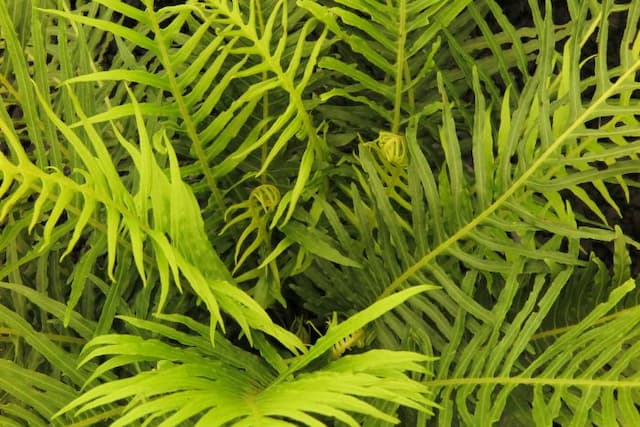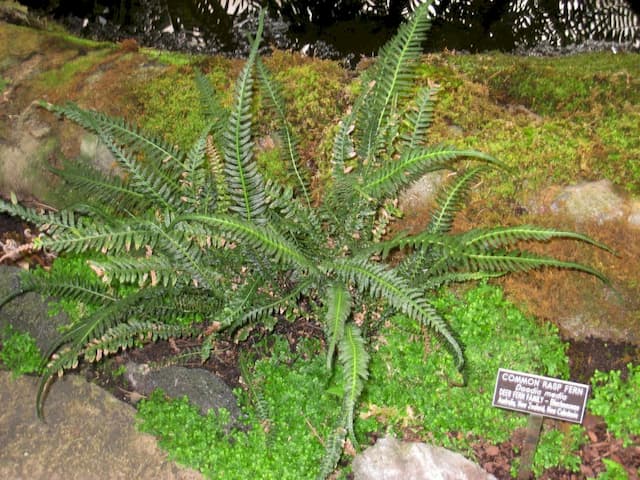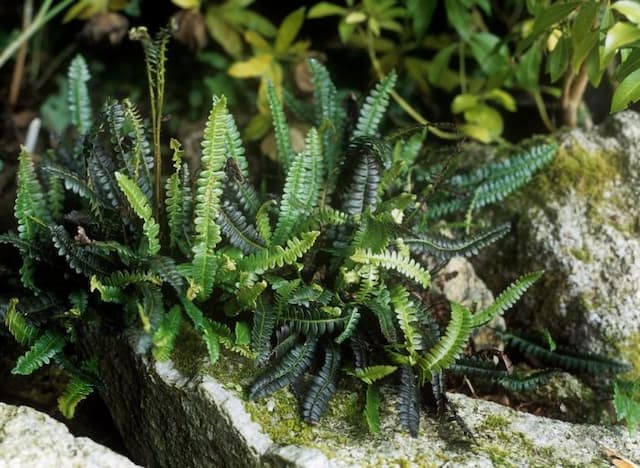Brazilian Dwarf Tree Fern Blechnum brasiliense Eruption = 'Alceru'
![dwarf Brazilian tree fern [Eruption]](/_next/image?url=https%3A%2F%2Fplants-admin.emdemapps.com%2Fimages%2Fplants%2F%2Fimages%2F604b5592bbce2.png&w=3840&q=75)
ABOUT
The plant known as 'Alceru' is marked by its striking foliage that displays a variety of hues. Typically, the leaves emerge a fiery red, evoking the imagery of molten lava, before gradually transitioning through a spectrum of oranges and bronzes. As the leaves mature, they settle into a deep, glossy green coloration, creating a visually compelling contrast against the newer, brightly colored fronds. The fronds themselves are structured and resemble a feather in shape, having a central stem from which numerous leaflets extend on either side, producing a symmetrical look. These leaflets are narrow, with somewhat smooth edges, and present a crisp texture. The impact of the plant's appearance is amplified further by the arching nature of the fronds, which splay out from the center, giving the plant a fountain-like characteristic that adds to its ornamental charm.
About this plant
 Names
NamesSynonyms
Red Brazilian Tree Fern, Brazilian Dwarf Tree Fern
Common names
Blechnum brasiliense Eruption
 Toxicity
ToxicityTo humans
Blechnum brasiliense, commonly known as Brazilian tree fern, does not have a widespread reputation for being poisonous to humans. However, there is limited specific information available about the toxicity of the 'Alceru' cultivar. In the absence of detailed toxicological data, it is advisable to avoid ingesting any part of the plant, as with many ornamental plants that have not been established as safe for consumption. If Brazilian tree ferns were found to be poisonous, symptoms may vary depending on the toxic compounds present, but could potentially include gastrointestinal distress such as nausea, vomiting, and diarrhea, along with possible skin irritation from handling.
To pets
The Brazilian tree fern is not commonly known to be toxic to pets. But, as with their effect on humans, there is minimal information on the specific 'Alceru' cultivar's toxicity. Pet owners should prevent pets from ingesting any part of the plant, since its safety is not well documented. In general, if a pet ingests a plant that turns out to be toxic, symptoms might include vomiting, diarrhea, drooling, or more severe signs like tremors or respiratory issues, depending on the nature of the toxic elements contained within the plant.
 Characteristics
CharacteristicsLife cycle
Perennials
Foliage type
Evergreen
Color of leaves
Varies
Height
4 feet (1.2 meters)
Spread
3 feet (0.9 meters)
Plant type
Fern
Hardiness zones
9
Native area
South America
Benefits
 General Benefits
General Benefits- Ornamental Appeal: Adds a tropical aesthetic to gardens with its vibrant reddish-bronze fronds.
- Easy to Grow: Tolerant of a range of soil types and can thrive in both full and partial shade.
- Low Maintenance: Requires minimal care once established, making it suitable for novice gardeners.
- Drought Resistance: Once established, it can tolerate periods of drought, reducing the need for frequent watering.
- Cooling Effect: Its dense foliage can provide shade and help cool the surrounding area.
- Habitat for Wildlife: Offers shelter and potential nesting sites for various species of birds and insects.
- Erosion Control: The root system can help stabilize soil and prevent erosion in sloped gardens.
- Seasonal Interest: With fronds changing color throughout the seasons, it offers year-round visual interest.
 Medical Properties
Medical PropertiesThis plant is not used for medical purposes.
 Air-purifying Qualities
Air-purifying QualitiesThis plant is not specifically known for air purifying qualities.
 Other Uses
Other Uses- The Brazilian Dwarf Tree Fern can be dried and its fronds used for craft projects, such as making natural wreaths or adding texture to floral arrangements.
- Young, tender fronds of the Brazilian Dwarf Tree Fern can be used as a natural form of packaging material to wrap items, much like using straw or hay.
- Because of its dense foliage, the Brazilian Dwarf Tree Fern can be integrated into sound barrier landscaping to help absorb noise pollution in urban gardens.
- The fibrous roots of the Brazilian Dwarf Tree Fern, once dried and treated, can be used in the production of ropes or woven into mats and other durable goods.
- The plant can serve as a living mulch, covering the ground and retaining soil moisture in garden beds, reducing the need for frequent watering.
- Cut fronds from the Brazilian Dwarf Tree Fern may be used as a natural brush or broom for cleaning dust in outdoor settings or workshops.
- In terrariums or vivariums, the Brazilian Dwarf Tree Fern might be used to create a miniature forested landscape, providing shelter and humidity for small reptiles and amphibians.
- The stalk of the Brazilian Dwarf Tree Fern can be hollowed out and used in creating rustic natural plant stakes or supports for other plants in a garden.
- During theatrical productions or photo shoots, the Brazilian Dwarf Tree Fern can be used for creating lush, tropical backdrops or as part of set design to evoke a rainforest environment.
- The Brazilian Dwarf Tree Fern might be incorporated into outdoor educational spaces, like school gardens, to teach students about fern life cycles and non-flowering plant reproduction.
Interesting Facts
 Feng Shui
Feng ShuiThe Brazilian Tree Fern is not used in Feng Shui practice.
 Zodiac Sign Compitability
Zodiac Sign CompitabilityThe Brazilian Tree Fern is not used in astrology practice.
 Plant Symbolism
Plant Symbolism- Regrowth: Blechnum brasiliense Eruption, commonly known as Brazilian Dwarf Tree Fern, often symbolizes regeneration and new beginnings due to its fern lifecycle involving spore dispersal and renewal.
- Resilience: As a hardy fern that can thrive in various conditions, the Brazilian Dwarf Tree Fern represents resilience and the ability to adapt to changing environments.
- Endurance: The persistent nature of this fern, which grows back even after being cut down or burned, stands for endurance and persistence through challenges.
- Prehistoric Connection: Ferns are an ancient group of plants, and the Brazilian Dwarf Tree Fern evokes a sense of connection to the prehistoric world and the continuity of life through time.
 Water
WaterThe Brazilian Tree Fern, should be watered regularly to maintain evenly moist soil, particularly during the warmer months. Watering once a week with about 16-32 ounces of water should suffice, but always check the top inch of soil for dryness before watering again. During the winter months, you can reduce watering to every other week, depending on the humidity and temperature of your environment. It's important to avoid waterlogging, so ensure the plant has good drainage and that excess water can escape.
 Light
LightThe Brazilian Tree Fern thrives best in bright, indirect light. It can tolerate some shade, but too little light may hinder its growth. A north-facing or east-facing window where the sun's rays are not direct would be an ideal spot, providing a gentle but consistent light source throughout the day.
 Temperature
TemperatureFor the Brazilian Tree Fern, ideal temperature conditions range between 60-80 degrees Fahrenheit. This plant can tolerate a minimum temperature of around 50 degrees Fahrenheit, but growth will be slower in cooler conditions. Extreme temperatures below 50 degrees Fahrenheit or above 80 degrees Fahrenheit can cause stress and potential damage to the plant.
 Pruning
PruningPruning the Brazilian Tree Fern is mainly for removing dead or yellowing fronds, which can be snipped off at the base with clean, sharp scissors. Pruning improves the plant’s appearance and prevents potential pests and diseases. The best time for pruning is in the spring when the plant is entering its active growth phase. Pruning can be done as needed throughout the year whenever you observe unsightly or damaged fronds.
 Cleaning
CleaningAs needed
 Soil
SoilThe Brazilian Dwarf Tree Fern thrives best in a rich, well-draining soil mix composed of peat, pine bark, and perlite or pumice, maintaining a slightly acidic to neutral pH of about 5.5 to 7.0.
 Repotting
RepottingBrazilian Dwarf Tree Fern should be repotted every 2 to 3 years to refresh the soil and accommodate its growing roots, best done in spring or early summer.
 Humidity & Misting
Humidity & MistingBrazilian Dwarf Tree Fern prefers high humidity levels, ideally between 60% to 80%, to mimic its natural rainforest habitat.
 Suitable locations
Suitable locationsIndoor
Place in bright, indirect light with high humidity and good air circulation.
Outdoor
Part shade, sheltered location, high humidity, protect from strong winds.
Hardiness zone
9-11 USDA
 Life cycle
Life cycleBlechnum brasiliense Eruption 'Alceru', commonly known as Brazilian Dwarf Tree Fern, begins its life as a spore, which germinates to form a tiny, heart-shaped gametophyte. On this gametophyte, both male and female reproductive organs develop, allowing for fertilization and the growth of a sporophyte – the fern's vegetative stage. The plant then forms a rhizome from which fronds emerge, unfurling from coiled croziers to reveal their characteristic reddish coloration that matures to deep green. As it matures, the Brazilian Dwarf Tree Fern establishes a short, erect trunk and continues to produce a crown of arching, pinnate fronds, becoming a small but impressive feature in the landscape or garden setting. This fern reaches reproductive maturity when it develops sori on the undersides of its fronds, which contain the spores that will disperse to start a new generation. Throughout its life, the plant requires consistently moist, well-drained soils and shaded to partially shaded conditions to thrive.
 Propogation
PropogationPropogation time
Spring to Summer
Propogation: Blechnum brasiliense Eruption, commonly known as the ‘Alceru’ red dwarf tree fern, is typically propagated by spores, which is the most popular method for ferns. Spore collection should be done when the spores on the underside of the fronds are ripe—often noticeable when they turn a brown color. The spores are then sown on the surface of a moist sterile potting mix, such as finely milled peat or a peat-perlite blend. To maintain a high humidity level essential for spore germination, the container is usually covered with a transparent lid or plastic wrap. The appropriate time to sow spores is generally in the spring when temperatures are warm but not excessively hot, typically between 68°F to 72°F (20°C to 22°C). It's important to keep the sowing media consistently moist but not waterlogged. Germination can take several weeks to months, and once the sporelings are large enough, they can be carefully transplanted into individual pots.









